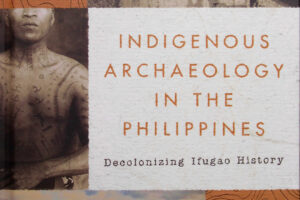By Jonathan Best
Book Reviews
Indigenous Archaeology in the Philippines: Decolonizing Ifugao History
By Stephen B. Acabado and Marlon M. Martin
The Ifugao Ethnographic Encyclopedia
Edited by Stephen B. Acabado and Marlon M. Martin
TWO NEW BOOKS by the same two authors have come out recently and are major contributions to the understanding of Ifugao culture on the Grand Cordillera mountains of Northern Luzon and a new approach to historical research and archaeology. Neither book is a conventional historical narrative but they both contain important historical information regarding the extended Ifugao community and a great deal of information and commentary regarding Ifugao the Rice Terraces, Ifugao material culture, folkways, spiritual life, and their relationship to the outside world.
The first book, published by the University of Arizona Press in 2022, titled Indigenous Archaeology in the Philippines: Decolonizing Ifugao History by Stephen B. Acabado and Marlon M. Martin, reports on the archeological findings of the Ifugao Archaeological Project in collaboration with the Save the Ifugao Terraces Movement. The two authors started working together with their respective colleagues over 10 years ago to research Ifugao history from a primary excavation they initiated at the old site of Kiyyangan Village in Ifugao Province. While doing so they tried to develop a more “ethical role” for archaeology, embracing community inclusive research methods with serious attention paid to local folk knowledge and traditions and concern for the education and cultural needs of the current “descendent community.”
The second book, The Ifugao Ethnographic Encyclopedia by the same two articulate authors, this time as editors, came out just this year and is a very useful follow-up to their first book. Whereas the first book tended to focus primarily on early historical anecdotes and new archaeological evidence along with recorded interactions with the present-day community, this second book is a wealth of visual and written information about the material culture and mythology of the present-day Ifugaos living and working in the spectacular landscape of their ancestral rice terraces.
Of the two authors Mr. Martin is a member of the Ifugao community and head of the Save the Ifugao Terraces Movement and an advocate for preserving cultural landscapes using modern scientific research methods in close collaboration with indigenous stakeholders. Mr. Acabado is a professor at the University of California – Los Angeles (UCLA) in the United States, and works on many archaeological projects around the world with an emphasis on interdisciplinary collaboration, indigenous partnerships, and cultural sustainability. The funding for their first book was provided in part by the UCLA, American Indian Studies Center, the Cotsen Institute of Archaeology, and the UCLA Dean of Social Sciences. Their second book’s research and publication was assisted by a grant from the Henry Luce Foundation through the Center for Southeast Asian Studies of the University of California, and was published by the Savage Mind Publishing House in Naga City in the Philippines, an up-and-coming provincial bookshop and gallery.
Their first book reports on their current archaeological research, based on carbon dating of organic material from the stratified layers of their excavations and historical analysis of the pottery shards and beads recovered there. From these findings they estimate that the age of the rice terraces and the introduction of wet rice agriculture to Ifugao Province began approximately in 1650. From this they speculate that the transition from a reliance on tubers, gabi (taro), and camote (sweet potatoes), to wet rice cultivation for community subsistence might have been a direct result of lowland Filipinos fleeing up the Magat River valley to the Cordillera mountains to escape the Spanish colonizers. Their findings also confirm that the mountain inhabitants were not an isolated community and were actively trading with the lowlands for centuries, even acquiring foreign materials such as stoneware and porcelain jars, glass beads, and other manufactured goods.
These archeological findings lead them to discuss at length the negative effects of relying on “assimilationist” and “colonialized histories,” or even Filipino nationalist historians who have tended to gloss over, exoticize, or just ignore the national ethnic minorities’ cultural and spiritual accomplishments. These historians often times repeat urban-based, mestizo and elite Tagalog narratives. Despite the many claims that the Rice Terraces are 2,000 years old, the authors point out that there is very little if any evidence to prove that they are that old, as originally postulated by Western anthropologists such as Otley Beyer. This myth has been repeated over and over again by tour operators and on tourist brochures. Earlier writers had a tendency to either “romanticize” the indigenous minorities as lost tribes, or demonize them as wild, naked headhunters and avoided discussing the more painful political issues of resistance to colonialism and Western imperialism.
Jonathan Best is a senior consultant at the Ortigas Foundation Library.
The author’s second book, The Ifugao Ethnographic Encyclopedia, unlike their first, follows the format of an academic reference book but in a large format with numerous colorful illustrations and a great deal of informative annotations accompanying each entry. Messrs. Martin and Acabado list themselves as editors as this is a community project with much of the material provided by cooperative local informants. The writers continue with their advocacy for direct community participation, and this time present a rich display of Ifugao arts, crafts, and information concerning the accompanying rituals and beliefs which have been for centuries the foundation for the Ifugao’s technological and social accomplishments.
Many of these traditions, including the maintenance of the Rice Terraces, are threatened by the transition to modern social, economic, and technological developments. Much of the Ifugao’s relationship with their departed ancestors, core family genealogies and values, polytheistic beliefs determining seasonal planting and harvesting cycles, land ownership, health and general welfare have been preserved in their sophisticated rituals and chanted oral histories. At times, many of these rituals have been thoughtlessly censored by invasive and inappropriate Christian evangelization which has chastised older spiritual practices, and by well-meaning but naïve outside educators. This has had a “detrimental effect on Ifugao social cohesion” over the years.
Although a very inclusive community, the Ifugaos have had a well-defined class structure with the richest Kadangyan elite on top. Their social status was signified by their ownership of rice paddies, high quality textiles, gold and agate jewelry, antique Chinese jars, and the formidable carved Hagabi benches which took weeks of expensive ritualistic labor and feasting, to produce. Some rituals, like the famous Hudhud chant, recognized by UNESCO for its priceless addition to world oral histories, take days to complete by Mumbaki (ritual specialists) and elderly Ifugao women.
However, Martin and Acabado are eager to point out that despite modern challenges, the various Ifugao communities on the Cordillera are not static, dying historical entities as often characterized by Western “assimilationist historians,” but active and evolving communities which are confronting these evolutionary changes like many other marginalized communities around the world.
The colorful illustrations of Ifugao Gods in traditional attire, painted in a super-hero style by Matt Bulahao and the amusing drawings by Marcial Dulnuan, along with numerous photographic illustrations of artifacts add to the overall attractiveness of the second book. The authors have added some contemporary local photos and many important vintage photos by R. F. Barton, a thoughtful American writer and anthropologist who lived among the Ifugao and Kalinga communities in the first half of the 20th Century and was granted a Guggenheim Fellowship for his research on the Ifugao in the 1930s.
All-in-all, both books give a fairly comprehensive look at Ifugao history and material culture while at the same time making the case for indigenous communities to take control of their own historical narratives with the help of and progressive collaboration with outside experts. The communities themselves, whether Ifugao or others, should be consulted as to how best to pass on cultural and historical information to the next generation. As the authors conclude in their first book, Indigenous Archeology in the Philippines: “For the modern Ifugao who stands on the threshold of cultural loss, community archaeology serves as an aid to self-discovery and revitalized ethnic identity.”
The books can be ordered online from their respective publishers.
Jonathan Best is a senior consultant at the Ortigas Foundation Library.

